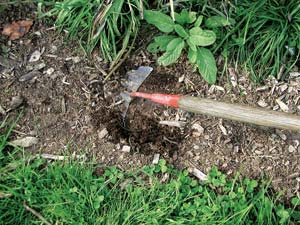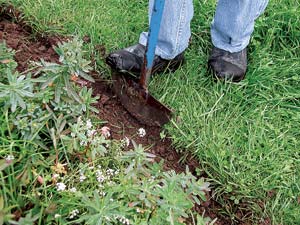
Weeding the weedless garden
 After
laying out his initial weedless garden, Lee Reich's gardening
year is almost too simple. He estimates that he spends only about
five
minutes a week weeding his 2,000 square foot garden, making sure that
he catches the few weeds that appear before they set seed.
Usually, he simply yanks up tiny weeds by hand, but if a slew of small
weeds pop up, he cuts the plants off just beneath the soil surface
using a colinear hoe, hula hoe, or (his favorite) the winged weeder.
After
laying out his initial weedless garden, Lee Reich's gardening
year is almost too simple. He estimates that he spends only about
five
minutes a week weeding his 2,000 square foot garden, making sure that
he catches the few weeds that appear before they set seed.
Usually, he simply yanks up tiny weeds by hand, but if a slew of small
weeds pop up, he cuts the plants off just beneath the soil surface
using a colinear hoe, hula hoe, or (his favorite) the winged weeder.
One problem I've noted
in my own endless hand-weeding is that I yank up
quite a bit of good garden soil around the roots of large weeds and
end-of-the-year crop debris (like dead corn stalks and broccoli.)
Lee Reich has a great solution to this problem. He uses a sharp
knife to cut a circle in the soil around the plant, severing the large
roots so that he can simply twist the main stalk out with a jerk of his
hand. Not only does the precious soil stay in place, there is
less disruption that will allow weed seeds to sprout. As an added
bonus, the small roots left behind quickly rot, leaving channels
through which air and water can move, and increasing the organic matter
of the soil.
At the end of the year
(or earlier if he sees bare spots), Lee Reich
adds another layer of mulch to the garden. He generally uses
leaves or wood chips around his perennials, wood chips in his garden
aisles, and weedless compost as mulch on the vegetable beds. An
inch of compost feeds his garden while all perennials except his prize
fruit trees receive enough nutrients from their three annual inches of
wood chip mulch alone.
 I probably spend about a
third of my weeding time dealing with the grass and clover that creep
up from our aisles into the garden beds.
Lee Reich agrees that edging is a pain in the butt and most of his
solutions are tedious and time-consuming --- hand weeding or cutting
off the invaders with a half moon edger are the two cheap
options. At the other exreme, if you can spare the biomass, using
wood chips in your aisles and as a buffer around your garden will not
only cut back on this time-consuming work, but will also feed your soil
and give your garden plants a bit more space to spread their
roots. One day, I dream of converting my aisles to wood chips ---
maybe if my buddies drop off another dozen truckloads full.
I probably spend about a
third of my weeding time dealing with the grass and clover that creep
up from our aisles into the garden beds.
Lee Reich agrees that edging is a pain in the butt and most of his
solutions are tedious and time-consuming --- hand weeding or cutting
off the invaders with a half moon edger are the two cheap
options. At the other exreme, if you can spare the biomass, using
wood chips in your aisles and as a buffer around your garden will not
only cut back on this time-consuming work, but will also feed your soil
and give your garden plants a bit more space to spread their
roots. One day, I dream of converting my aisles to wood chips ---
maybe if my buddies drop off another dozen truckloads full.
Lee Reich even has
contingency plans for what to do if you accidentally
let a portion of your garden become over-run with weeds. Just
throw down a new kill mulch complete with paper weed barrier and keep
right on planting!
| This post is part of our Lee Reich's Weedless Gardening lunchtime
series.
Read all of the entries: |
Want more in-depth information? Browse through our books.
Or explore more posts by date or by subject.
About us: Anna Hess and Mark Hamilton spent over a decade living self-sufficiently in the mountains of Virginia before moving north to start over from scratch in the foothills of Ohio. They've experimented with permaculture, no-till gardening, trailersteading, home-based microbusinesses and much more, writing about their adventures in both blogs and books.
Want to be notified when new comments are posted on this page? Click on the RSS button after you add a comment to subscribe to the comment feed, or simply check the box beside "email replies to me" while writing your comment.

According to the wikipedia article on mulch;